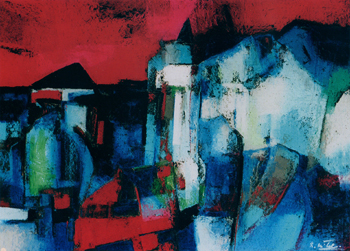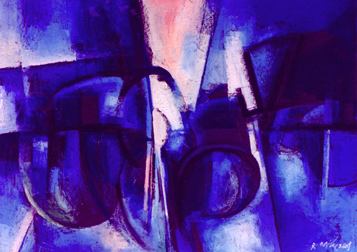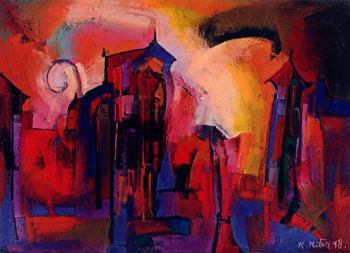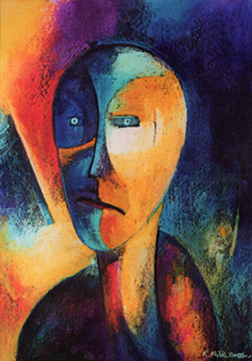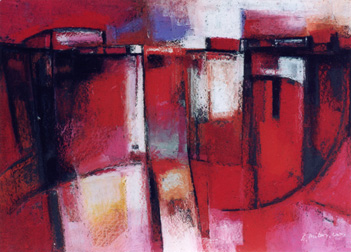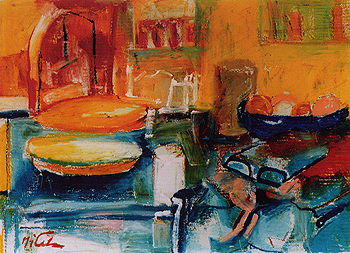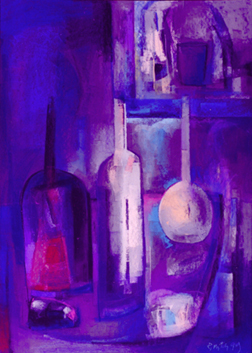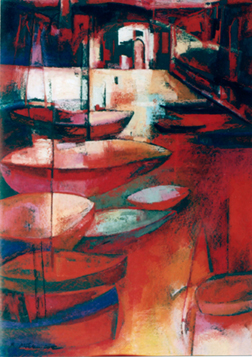PERCEPTION, FORM, & ESSENCE
pastels
by Ryszard Milek
(of Nowy Sacz, Poland)
THE HYGIENIC
ARTS CO-OP GALLERY
77 Bank Street
New London, Connecticut
April 30 - May 26, 2005
*********************************************************************
YORK SQUARE GALLERY
61 Broadway, New Haven, Connecticut
Artist Reception:
Sunday, November 23, 4:00 - 6:30 PM
Exhibition: November
22 - December 29, 2003
*********************************************************************
THE MADISON ARTS CINEMA
761 Boston Post Road, Madison, Connecticut
January 1 - February 12, 2004
*********************************************************************
PLAYHOUSE-ON-THE-GREEN
761 Boston Post Road, Madison, Connecticut
March 8 - August 31, 2004
*********************************************************************
Ryszard Milek was born in Poland in 1955. He is presently one of the top five selling artists in Poland. He is an art historian & theorist, and graduated from the Secondary School for the Fine Arts in Tarnow, Poland and the Catholic University in Lublin, where he studied art history. He draws and paints, and also writes artistic critiques. In 1990, he organized an exhibition of Jozef Czapski's (1894-1993) paintings, one of the leading Polish European artists of the 20th century.
For several years,
Ryszard was the art history lecturer at WSB-NLU (Wyzsza Szkola Biznesa-National-Louis
University) in Nowy Sacz, Poland. He also taught art in primary and secondary
schools.
"Ryszard
Milek's artistic pastels"
essay by Lechoslaw
Lameriski
Ultimately,
I really don't know, what I like, esteem and respect in Ryszard Milek's
painting. With curiosity and interest I look at his numerous landscapes,
still lifes, faces or nudes, which all attract, fascinate and draw my
attention. These are compositions which use an exceedingly difficult pastel
technique, requiring a steady hand and a certain intuition. This technique
was particularly respected and mode popular by the Mtoda Polsko (Modernism)
artists with Stanistaw Wyspianski the unquestioned master in this field.
Oil-pastel, which produces effects typical for oil-pointing, was introduced
into Polish artists' ateliers at the turn of the 19th century, and is
still used today. Among those, who treat pastel seriously, not only as
a source of "curry favoring" income, with portraits mode to
please the customers and stirring landscapes, Ryszard Milek has found
a place for himself.
The artist
joins two, to some extent, complementing aspects: his profession as an
art historian - theorist and a real experienced artist, practitioner.
It is difficult to say explicitly, which aspect has gained more by this
dualism. For sure, a particular theoretical knowledge acquired during
his studies at the Catholic University of Lublin, helped Milek to ovoid
making mistakes typical for, as we call them, "young rebels".
On the other hand, it seems that, his art history studies changed the
life of the alumnus of the Secondary School of Fine Arts in Tornow. The
more so as since he had his first individual exhibition (BWA in Nowy Sacz,
1994) ten years after he had graduated from university.
Did the
artist - historian of art - need so many years to be able to use his own,
easy to recognize, set of signs and artistic forms, original and attractive
enough to make him one out of ten the best-bought Polish artists in 1997?
Surely he did, and history has known many outstanding artists who didn't
live to see even the most modest signs of esteem and approval for their
art, while today, their works are worth fortunes in the biggest auction
rooms in Europe and all over the world. Is Ryszard Milek only on artist
created by an unusual coincidence which occurred in a particular time
and place? Maybe this "crazy" dreamer and optimist as well as
the realist stepping on firm ground (born in Grodek on the Dunajec River),
is someone who like a comet with its unique shape and brightness, can
disappear the moment the market is saturated with his works full of warmth
and poetry. I don't think it can happen. An analysis of his pointing to
date shows that time has been working advantageously for him.
An authentic
talent, sensitivity to color and especially a synthesized view of surrounding
reality, supported by o creative passion, mean that his paintings have
become more and more interesting and mature. A complete Ryszard Milek
is found in numerous groups of work, but which never make a closed entirety
even after a few years. These are works which above all reflect his inner
world, a world having enough room for near his home and his heart. These
are found in his sketch-book during his numerous wanderings (including
his favorite water motives, mountains and old, wooden buildings in Krynica-Zdi6j).He
also has abstract landscapes and modest still lifes (primarily with flowers
or bottles) nudes and anonymous - yet with a strong artistic personality-faces,
and several compositions brimming over with a mystical religiousness in
which one can identify icons.
Analyzing
Ryszard Milek's painting we can't forget his drawings which have always
accompanied him. His drawings, especially the lines creating them are
tense, limited and extremely precise. They ore astonishingly similar to
Jozef Czopski's draft sketches. The artist admits that this great copyist
(whose famous exhibition Milek organized in BWA, Nowy Sacz 1990) is one
of his favorite artists. The similarity between Milek and Czapski lies
in the fact that they both have on analogical perception of the world.
This is the look of an attentive observer gifted with a sense of synthesis.
He notes everything from a distance, and deliberately, at the decline
of the day, preferably in the solitude and tranquillity of his atelier
where he sketches chosen pieces of well-remembered reality. Simple pieces,
outwardly clear, say so much about the ordinariness present during o rest
on a bench in the park, while sailing a boat on the lake or during a frugal
meal at the kitchen table with a cup of coffee and of plate of ripe apples.
Ryszard Milek's painting seems to evolve in the some direction, but the elegant line in his black and white drawing has been replaced with a soft line of contour, gradually introducing suggestive colors. From softened almost faded colors carefully mixed and composed on the palette to an eruption of a riot of vivid waterfall colors overflowing like streams of clotting lava -- they are sets of abstract stains.
Looking
at Ryszard Milek's pastels is like looking at a beautiful, scrupulously
edited album of painting, turning page after page, with special care not
to damage them. The paper fits the character of the painting and the excellent
quality of printing.
The artist
himself simplifies our contemplations. His series of paintings created
in turns and simultaneously, show us how the same theme develops and changes
throughout the years. The "Faces" series allows us to notice
the greatest maturity and originality of this interesting painting. One
of the youngest (initiated in 2001) is comprised of dozens of very significant
works. Works showing how for the competent mastery of technique supported
with an extended artistic consciousness allows one to paint anonymous
(created in the artist's imagination) faces. Faces, charming with their
sophisticated expression and clear study, very often refer knowingly and
provocatively to the most important art styles of the 20th century. At
the same time, there are faces which effectively render different mental
states, from dark pessimism to joyful euphory. In Ryszard Milek's "Faces"
everything can be found-what he has seen (at the cinema, on the street,
during a walk or a long journey), what he has read, or what somebody told
or wrote him. This is both a real and an imaginary world, originated in
the artist's receptive and sensitive psyche. Milek's pastel "Faces"
are masterpieces of this style.
Although
Ryszard Milek's artistic way of thinking and looking is also present in
his still lifes which ore simple in form and essence. I prefer, the very
simplest ones, showing only few bottles or empty water glasses and jars.
Their transparent structure enables the areas to penetrate themselves
against the rules of perspective and methods of showing depth, compulsory
since the Renaissance.
The artist
consciously simplifies even the simple shapes of his models, shor- tens
the views, raises the line of horizon, slurs the limits between the views
and like Cezanne uses different points of perceiving the same objects,
crowding the foreground to the highest
degree. Ryszard Milek's still lifes emanate with the great power of expression
being the sum of experiences, allowing him to paint various versions of
very colorful still lifes. The variety is made with a wide range of subtle
shades of block supplemented occasionally with soft "chords"
of white. These paintings give the impression of being very old. Milek,
trying to reach the noble patent of time, rubs the dye gradually into
the rough surface of the background bluring the contours, at the same
time, emphasizing, with single spots of light, the relief pieces. Here
sees again a similarity to the last still lifes by Jozef Czapski when
he was almost blind. They were painted "from memory", to spite
a great coloristic past. With Czapski it was caused by his old age and
physical condition, but for Milek it was a conscious choice, the desire
to show spectators and critics that such a subtle and soft pastel
technique can be "polyphonic", even when the pointing is created
by different "chords" of black, gray and occasionally white.
A separate problem in Ryszard Milek's works is landscapes ranging from almost postcard views of Krynica-Zdroj to landscapes that have an abstract look of the trees and hills which are reflected in the calm waters of a lake. It is interesting that the artist willingly demonstrates the formal effects which classical pastel techniques create. But then in the next landscape of a set - it seems to be substitute of an oil-painting with its specific facture simply put on a cardboard with a palette-knife. I feel that when the artist abandons the literary for the abstract, his landscapes attain cohesion and a power of expression.
At the
end, a few words about Ryszard Milek's "icons". They aren't
the kind of icons normally associated with the name. Their "iconness"
is based on pointing - as usually Milek does - anonymous human shapes
with on aureole around the sketchily presented heads, shapes standing
in concentration and perceptible isolation from the other similarly presented
figures existing on the border line of two worlds - real, the Earth's
and transitory, divine. What distinguishes icons from other sets of paintings
is a perceptible element of mysticism and close, simple piety of an average
man giving all his soul to God.
I hope,
that Ryszard Milek's pointing will not become commercialized and, that
the esteem he enjoys and his place on the art market will not kill his
sense of self-preservation, which will let his admirers see and contemplate
- more interesting paintings from the sets: "Faces," "Still
Life," landscapes with the architecture', "Abstract Landscapes'
and" Icons', as well as other yet unpainted sets.
Lechoslaw Lameriski
